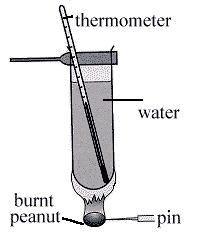

Living Things - Levels 5 - 7 - Answers
[ Questions ]

1. _same mass of nut and cracker; same _
2. _volume of water; same starting temperature_
__ wear goggles/ tie hair back; stand well back; etc __
The table shows information printed on a packet of peanuts and a packet of cream crackers.
| Energy in kJ. | Protein in g. | Carbohydrate in g. | Fat in g. | Fibre in g. | |
| 100g. of cream crackers | 2156 | 9.1 | 62.4 | 25.4 | 4.8 |
| 100g. of peanuts | 2411 | 28.8 | 12.9 | 46.0 | 7.2 |
__________ peanut ____________
______ contains large amounts of energy/ large amounts of food value in small volume ______
_____ We are unable to digest/ breakdown fibre _____
__ prevents constipation; provides bulk; keeps food moving through your gut; keeps your gut healthy _
Air is a mixture of gases. It contains nitrogen, oxygen, water vapour, noble gases and carbon dioxide. The air we breathe in (inhaled air) and the air we breathe out (exhaled air) are different. List three differences in the composition of inhaled and exhaled air.
a) _____ more carbon dioxide _______
b) _____ less oxygen ______________
c) ____ more water vapour/ moisture __
______ trachea/ wind pipe _____
to keep the tube open/ to prevent the tube from flattening
This is part of the complex food web in a forest.

Basing your answers on this information only:
top carnivore: hawk, fox, buzzard
herbivore: caterpillar/ aphid
(i) the number of foxes?
might reduce because less food is available
(ii) the number of mice?
might reduce because more of them are eaten by the foxes
energy is lost as heat or by respiration or to fly/ move etc.; Some food is wasted/ not digested/ excreted.
